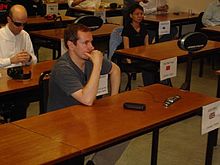Speed Cards
Speed cards is a form of memory sport . The point is to memorize the order of a well-shuffled deck of cards with 52 cards in the shortest possible time. The world record is currently (as of 8/11) at 21.9 seconds, held by Simon Reinhard . This corresponds to a time of around 0.42 seconds per card.
Problem
The great difficulty or the great attraction of the discipline is the fact that you cannot repeat the stack for reasons of time. The sequence must therefore be firmly in the memory on the first run.
procedure
There is a one-minute concentration phase before memorizing. During this time, the memory athlete has the opportunity to collect his thoughts in order to then be completely at the point. During this concentration phase, the deck of cards, which the referees had shuffled well beforehand, is already on the table. At the end of the concentration phase, the organizer says the words: Neurons on the ready. Go! After this start signal, the memory athlete begins to memorize. That is, he fans out the pile and notes the order of the cards. When he's done, he gathers the cards back together and puts it on the table as quickly as possible. The time is stopped. The athlete then receives another deck of cards sorted by color and value. He tries to put this new pile in the order of the first pile. He has a maximum of 10 minutes for this. After the replay, a referee checks whether the deck is faultless by revealing the two decks of cards in parallel.
reproduction
Playback takes place after the 5 minutes memorization time has elapsed. The athlete receives an ordered deck of cards for them, which he has to put in the order of the previously memorized.
Timing
Stack mats are used to measure time. Previously, the times were taken by referees with hand stopwatches. The time mat with timer is a device in which the athletes stop themselves. It has contact surfaces on which the athlete places his hands. When a hand leaves contact, the timing starts. When the athlete has finished memorizing, he places his hands back on the contact surfaces, which stops timing and shows the time required.
Scoring
To score the discipline at memory championships, there is the so-called Millennium Standard. As in other memory disciplines, this is slightly higher than the world record: 25 seconds. He is the key to the calculation, which is done as follows:
[1000 / (x in sec / 25)] * [y / 52] (x = time it took to memorize, y = correctly played cards)
If an athlete memorizes the stack in 25 seconds, he gets exactly 1000 points. If he has one or more errors in the playback, the time is automatically set to 5 minutes and counted up to the first error. If he has the 27th card wrong, the first 26 cards are correct.
Strategies
It is very difficult to remember a well-shuffled deck of cards with natural memory. All memory athletes therefore use different mnemonic techniques . The so-called loci (from Latin place) or route method is used by all of them . You go through mental routes in your head and link images with the individual points of the route. For example, if the route is your own apartment, which begins with a chest of drawers in the entrance, and the first word to remember is "freedom", then you would imagine the Statue of Liberty on the chest of drawers. To memorize abstract material (here cards) one assigns images to the individual information units. This can be done either arbitrarily or according to a specific letter code.
1 system
Here you have an image for a map that is linked to the route point. The disadvantage of this approach is the high demand for route points.
Story building
Here you only have one picture per map, but you create stories from the individual pictures, which you then store on the route point. This saves route points. In addition, the higher the level of imagination increases the recall rate.
PVO system
In the PVO system has for each card three images: a P erson, a V erb and O bjekt. These are linked to a mini story, which you then put on the point.
Ben system
The so-called Ben system is a memory system developed by Ben Pridmore . It uses one image for two cards. This results in 2704 images. Ben Pridmore himself links these to a small story of three pictures each before placing them on the route point. However, this should not be confused with the PVO system. By storing several images on a route point, on the one hand, time is saved that is required for changing route points. On the other hand, you save route points and have a better overview with around 20 mental images, which are distributed in pairs of 3 on around 7 route points. The last cards in a pile are transferred to the working memory, which can usually take around 6 images without any problems, and after the time has stopped, memorized using the loci method.
Speed Cards Challenge
On June 24, 2006 the Speed Cards Challenge took place for the first time . Two memory athletes competed against each other. The participant with the better memorization time won. The competition was carried out according to the Swiss system . The winner was Ben Pridmore , second was Dr. Gunther Karsten , third Alisa waiter .

